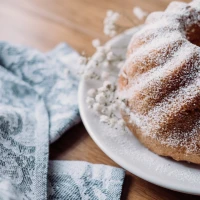Lemon poppyseed scones offer a delightful balance of tangy citrus and subtle, nutty flavors wrapped in a tender, buttery crumb. This classic combination has become a cherished staple in cafes and bakeries around the world. But achieving that bakery-quality goodness at home can be quite the feat. For those seeking to recreate these zesty morsels in their own kitchens, understanding the nuances can make all the difference. From selecting the perfect lemons to mastering the scone’s texture, each step is crucial in producing a batch that’s as irresistible as those from your favorite bakery.
Ready to learn the secrets of making lip-smackingly good lemon poppyseed scones at home? Let’s embark on a culinary journey to unleash the full potential of this beloved baked good. Embrace the zest and let’s make your kitchen the newest hotspot for Vegetable-infused delectable delights!
1. The Right Ingredients Matter
Before you Preheat your oven, ensuring you have the freshest, highest-quality ingredients is your ticket to achieving the pinnacle of scone perfection. It all starts with the lemons. While it may seem like a minor detail, the type of lemon you choose can profoundly impact the flavor of your lemon poppyseed scones. Look for organic, unwaxed lemons for the best zesty kick and natural flavor.
Selecting the Best Lemons
Ensure your lemons are:
- Boldly aromatic: A strong lemony scent is indicative of higher essential oil content which translates to more flavor.
- Bright and firm: This hints at freshness, for that punch of citrus we all love.
Fresh Is Best
- Buy fresh poppyseeds: Poppyseeds can go rancid quickly; purchase them from stores with a high turnover rate to ensure freshness.
- Check for quality butter: Opt for unsalted butter that’s fresh and high in fat for a flaky, tender scone.
Flour Power
- Use the right flour: For a light and airy texture, choose pastry flour or a mix of all-purpose and cake flour to get that quintessential scone texture.
2. The Importance of Cold Ingredients
A non-negotiable in the realm of scone-making is using cold ingredients. Temperature control plays a pivotal role in achieving that flaky, layered texture and should not be overlooked.
Keep Your Cool
- Butter: It should be chilled and cut into small chunks, ensuring it stays solid amidst the dry ingredients to create small pockets of steam.
- Liquid ingredients: Whether it’s milk, cream, or buttermilk, keeping these icy will make a world of difference.
3. Perfecting the Lemon Poppyseed Flavor Profile
Making the perfect lemon poppyseed scone isn’t just about adding lemon to the dough. It’s a delicsmoke 10 lb brisket at 225e dance of aroma, taste, and texture.
Maximize the Lemon Essence
- Zest: Utilize the zest of lemons to infuse your scones with a robust, zesty flavor without altering the dough’s moisture.
- Balance: Finding the sweet spot between the lemon and sugar creates a harmonious profile where neither is too overpowering.
Poppyseed Proportions
- Striking the right balance with poppyseeds ensures every bite is speckled with their unique taste and crunch.
4. The Technique: Gentle Hands, Better Scones
The way you handle the dough translates directly to the final texture of your scones. Overworking the dough is a common pitfall, but it can easily be avoided.
Mix With Care
- Avoid Gluey Dough: Mix only until the ingredients are just combined, ensuring a tender crumb.
- Use a Pastry Cutter: This helps to incorporate the butter without melting it, thanks to hand warmth.
5. The Art of Shaping
Achieving uniformity in thickness and size isn’t just about aesthetics; it affects how your scones bake and rise.
Size Matters
- Consistency: Keep scones of the same size to ensure even baking.
- Thickness: A taller scone will be more moist inside, so aim for about 1 inch in thickness.
6. The Golden Glaze
A brush of egg wash on top of your scones before they go into the oven can be the difference between a good and a great scone.
Why the Glaze
- It provides a golden, glossy finish that’s not only visually appealing but adds a subtle richness to the flavor.
7. Baking to Perfection
Knowing your oven is crucial. Hot spots can result in uneven baking, and the correct temperature will ensure your scones are golden outside and soft inside.
Temperature Tactics
- Preheat: Give your oven ample time to reach the desired temperature of 400°F (200°C).
- Know Your Oven: Some ovens run hot or cold; an oven thermometer can make all the difference.
8. Cool for Success
The temptation to devour your scones hot from the oven is real, but allowing them to cool on a wire rack is key for texture.
Cooling Off Period
- Prevents the bottom from becoming soggy.
- Enhances flavor development: a scone’s taste matures as it cools down.
9. Storage for Longevity
Protecting your lemon poppyseed scones from the elements will preserve their quality and extend their shelf life.
Preservation Tips
- Airtight Containers: This keeps them fresh for longer.
- Freeze for Future Enjoyment: Wrapped properly, scones can be frozen for a quick treat later.
10. Serving and Pairings
To truly elevate your scone experience, consider what you serve them with or how you present them.
Pairing Perfection
- Cream and jam: A traditional but unbeatable combination.
- Tea or coffee: The right beverage can complement the citrus notes and enhance the overall experience.
With these 10 secrets revealed, achieving bakery-quality lemon poppyseed scones is within reach. Remember, good things take time, and rushing through the steps, blurring the lines between precise measures and rough estimates can lead to vastly different outcomes. Lemon poppyseed scones aren’t just treats; they’re an experience—one that begins with the scent of lemon zest wafting through your home and ends with the satisfaction of that first delectable bite. Whether you’re a seasoned baker or a curious novice, these tips will guide you to create a masterpiece that could very well become the next hit in your culinary repertoire.
Dive into the art of scone making; embrace the process, and relish in the joy that good food brings. Lemon poppyseed scones, with their bright, merry flavors and tender, buttery texture, are more than just a recipe—they’re a celebration. A celebration of the little things, like the way a waft of lemon makes us pause and the crackle of poppyseeds between our teeth. So, gather your ingredients, roll up your sleeves, and get ready to bake some magic into every bite.










